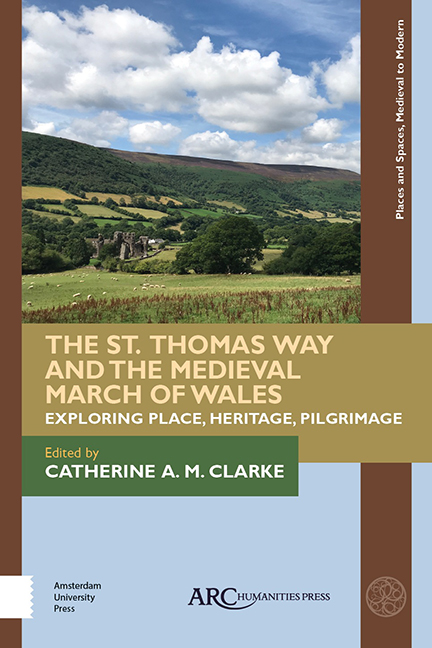Chapter 7 - String Theory for Beginners: The Art of Pilgrimage
Published online by Cambridge University Press: 20 November 2020
Summary
IF YOU’D TOLD me a year ago that I’d be making artwork touring Wales on a medieval research project with nothing more than a ball of string and some scissors, I would probably have laughed at this ridiculous idea. When I was invited to join the St. Thomas Way Project as Artist in Residence, I’d immediately imagined all those medieval works of art that we’re all so familiar with: the delicate pages of illuminated manuscripts, the intricate stone carvings adorning our medieval buildings, and the dazzling stained-glass windows of our Gothic cathedrals. And for map enthusiasts like me, of course, the strange and magical world depicted within Hereford's thirteenth-century Mappa Mundi.
Indeed, if you visit any of the thirteen waypoints along St. Thomas Way yourself (and I encourage you to do so), you will find many of these stunning examples of medieval art and craftsmanship— and more too. My “journey in making” for this project led me along the whole trail, looking closely at the architecture, the art, the landscapes, and all the details and quite wonderful visual clues I could find in every place I visited, all evidenced in the 2,794 photographs I took over the nine months leading up to the exhibition. But they were all eventually eclipsed by a humble piece of string.
A Cyclical Journey of Making
My work is process-based. That is to say, I don't set out with a fixed idea of what I’m going to make or the exact outcome. Instead, I let the places and people I meet and the processes I use help create the artwork. As an art student, during an exchange programme to New Mexico, I was introduced to the work of Joseph Campbell, the anthropologist who’d connected certain myths, rituals, and cultural practices from all around the world via the concept of “the Hero's Journey.” For me, the process of making artwork echoes its cyclical steps: following the call and setting out on a (creative) adventure— meeting a mentor— crossing the threshold into the unknown (no turning back)— facing trials, tests, and perils (where it's not working or coming together at all)— learning new skills— going into the abyss (yes, really)— reaching a point of transformation (this takes trust in the process)— and then returning, changed, with a gift (the finished artwork) and sharing (with an exhibition and through workshops).
- Type
- Chapter
- Information
- The St. Thomas Way and the Medieval March of WalesExploring Place, Heritage, Pilgrimage, pp. 125 - 132Publisher: Amsterdam University PressPrint publication year: 2020



